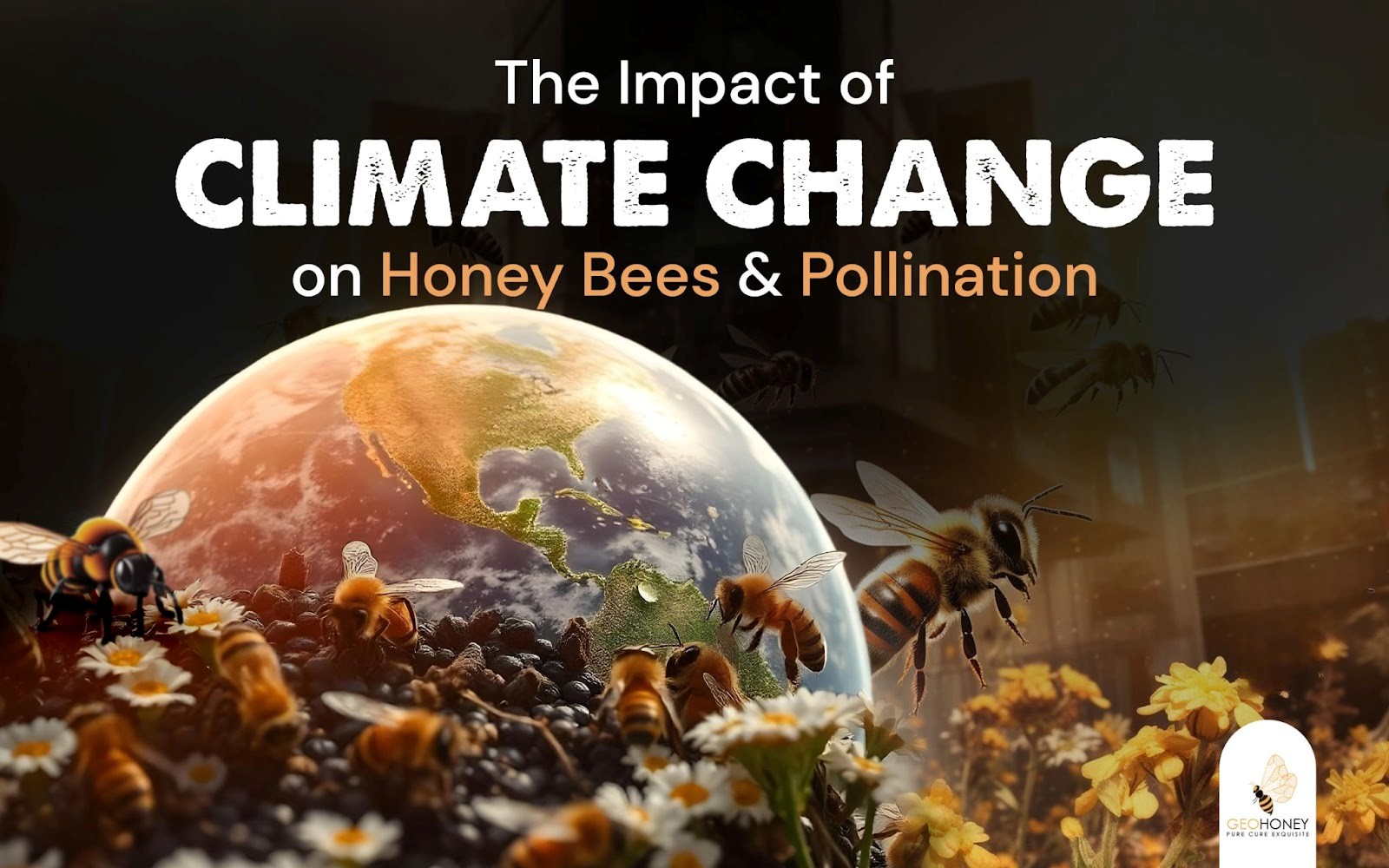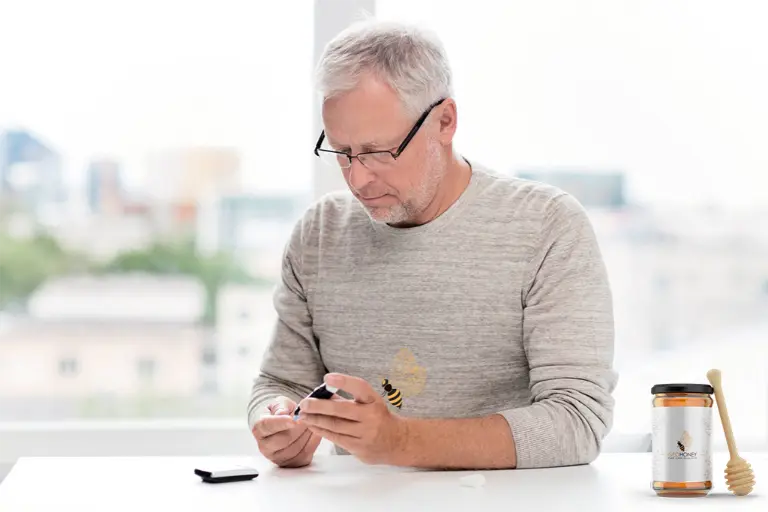- Tokyo: 00:23
- Singapore: 23:23
- Dubai: 19:23
- London: 15:23
- New York: 10:23
The Impact of Climate Change on Honey Bees and Pollination in 2025

Honey bees are highly resilient and adaptable creatures that date back over 33 million years with 20,000 different species currently known. Though this particular type of pollinator is able to thrive almost anywhere, we are constantly observing a decline in their population.
The main contributor to the falling population of honey bees is climate change which brings with it unusual weather patterns, intense heat, floods, droughts, forest fires, and much more.
This is what the CEO of B A Barry Group and the founder of Geohoney, Mr Basem Barry has to say
“Climate change has disturbed the peaceful coexistence between humans, plants, and honeybees and if left unchecked it can further complicate the survival of these key creatures of our ecosystem.”
But how does climate change affect honey bees and their pollination? This is what this blog is going to be about. So, if you are uncertain about the adverse effects of the recent climate crisis on the bees then keep on reading to learn more.
- Why are Pollinators Like Honey Bees So Important?
- Ways in Which Climate Change is Affecting Bees and Pollination
- Habitat Loss
- Weaker Bees
- Droughts & Floods
- False Springs
- Disturbed Colony Age Structure
- Mismatched Plant-Pollinator Timing
- Changing Floral Fragrances
- Changes in Plant Chemistry due to CO2 Emissions
- What Can We Do to Minimize the Effects?
Why are Pollinators Like Honey Bees So Important?
Pollinators like honeybees are an indispensable part of our lives. Without these creatures, about 75% of all the major food crops will never be able to grow which can seriously affect our food supply.
Pollination done by these bees is what gives us key food sources like apples, coffee, berries, broccoli, almonds, melons, monofloral honey, and much more.
Moreover, without honey bees, many wildflowers are not able to reproduce or bloom. This can reduce the number of such flower species.
With the decline in flower or plant species, the animals who feed on these are also affected greatly. This disrupts our planet’s ecology to a great extent which is why honey bees need to be protected from the climate crisis at all costs.
Ways in Which Climate Change is Affecting Bees and Pollination
Following are a few points that illustrate clearly the impact of climate crisis on honey bees and pollination
-
Habitat Loss
Climate change, human development, and the clear-felling of forests are all big contributors to the habitat loss of bees. The global rise in temperature limits pollination habitats by reducing the honey bee migration zones.
Bees that are evolved to live in colder climates are not able to survive in high-temperature environments. When the temperature rises, bees are forced to migrate from the hot places to cold ones which limits their ability to pollinate native plants.
-
Weaker Bees
Climate change is making bee colonies weaker every year which makes them prone to various parasites and diseases like Varroa mites, Nosema parasites, American Foulbrood Disease, etc.
Rapid climate changes disrupt the development cycles of these bees which further affects their physiology as well as behaviors negatively.
-
Droughts & Floods
Climate change is the leading cause of droughts. With scarcity of water in areas where bees are greater in number the hydration needs of these bees are not met. This destroys their habitat and reduces their overall population at the same time.
Droughts are also detrimental to plants that bees pollinate to make raw honey or to initiate the reproduction cycles. This also affects the global crop yield.
On the other hand, floods caused by rising sea levels are also a direct consequence of climate change. Floods not only destroy beehives but also eliminate their foraging grounds. This further leads to a reduction in the bee population.
-
False Springs
One consequence of climate change is the warmer winters with unpredictable freeze flashes as well as weather patterns. This causes bees to leave their overwintering state before the right time in search of nectar which they cannot find.
The bees that have left the hive in these false spring times freeze and die as the temperature suddenly falls down.
-
Disturbed Colony Age Structure
Climate change leads to lengthening summer and autumn. As high temperatures persist, the bees do not feel the need to hibernate for a longer time than they have to.
The prolonged foraging can mess with the age structure of the bees. The age structure of the colony gives us insights into the division of labor and defines how age-related events, like disease and death, can influence the health of the colony.
With the disturbed age structure of the colony, you see larger-than-typical numbers of older bees overwintering.
This can lead to a sudden die out of the older bees right at the beginning of spring. This prevents the colony from gathering the resources they need to survive the winter.
-
Mismatched Plant-Pollinator Timing
Premature blooming is another consequence of climate change which can cause some plant species to grow before the right time. This leads to mismatches in plant/pollinator timing. When plants bloom prematurely, they are more prone to damage or weakness with sudden temperature changes in the spring.
These plants are not able to survive for long which leads to limited resources for bees, a reduction in populations, or less honey production.
-
Changes in Plant Chemistry due to CO2 Emissions
Studies have shown that rising levels of CO2 not only increase the temperature but also have a bearing on plant chemistry. The research shows that higher CO2 leads to lower protein content in the pollen which can seriously affect bees who need this protein for development.
The limited protein content limits brood rearing in bees which shrinks their population. With a reduction in pollen quality, the bee larvae are not able to stay nourished which leads to weaker bees.
What Can We Do to Minimize the Effects?
Here are a few things we can do to make sure this keystone species is able to stay safe from the harmful effects of climate change
- You can help bees by providing them with pollinator-friendly gardens.
- You can reduce energy or fuel consumption which leads to more emissions.
- Make sure to add native plants in your garden to further facilitate pollination.
- You can adopt bee-friendly farming practices by minimizing the use of pesticides that remove floral resources, impair pollinators’ immune response, foraging and navigation abilities, as well as reproductive processes.
- You can support local beekeepers by buying honey and other related products. By using local products you can allow these beekeepers to expand their operations and do more for the bees.
- Buying from local beekeepers also eliminates the need to import these products which further reduces your carbon footprint.
Conclusion
The implications of the effects of climate change can be devastating for honey bees and pollination. This can endanger our global food system and the planet in general.
To minimize the harmful effects of climate change on these creatures we need to adopt a more socially responsible lifestyle both on individual as well as collective capacities.
The importance of honey bees in our ecological framework and their services as pollinators can never be understated. This is why it is up to us to ensure they are able to thrive and grow amidst the threats of climate change.
Geohoney is the leading honey brand based in Dubai with over 130 farms equipped with the latest new-tech monofloral initiatives. Our 100% pure, raw, and natural monofloral honey is carefully prepared using single nectar sources. Geohoney strives to produce monofloral honey that meets the highest global quality control standards while using environmentally sustainable resources.
Visit GEOHONEY today to buy the best pure monofloral honey to stay healthy and fit throughout the year.



